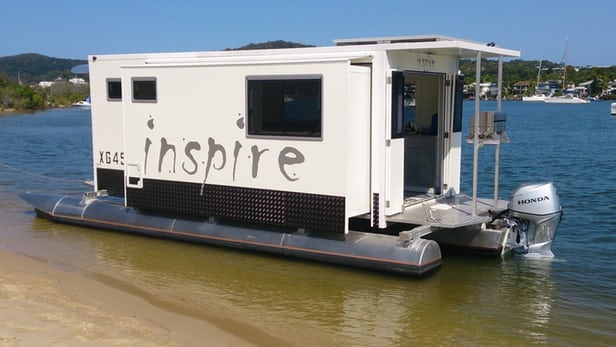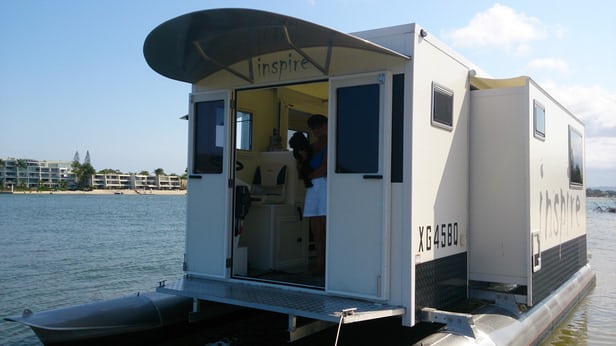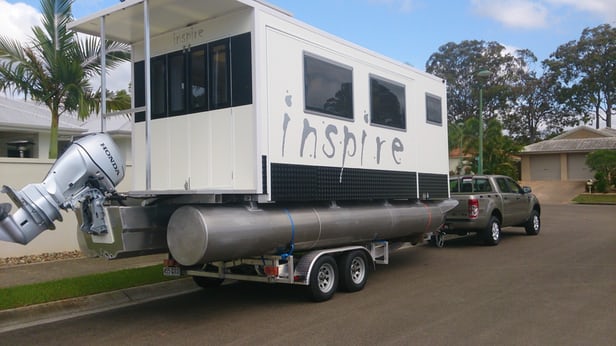A few weeks too late to be considered for our 2015 best caravans or water toys lists but an early candidate for next year, the Transformis Inspire is an interesting twist on the trailerable houseboat. It borrows from several other innovative products, including expandable boats and slide-out camper modules, to provide a comfortable land/water living space for touring the world by highway and waterway.
A German-born Australian transplant, Claudia Moffat is well aware of the wanderlust that comes with living in a new, exotic piece of the world. She helped satisfy her own wanderlust back in 2007, when she took a nine-month motorhome tour around Australia with her four-year-old son.
“On the road, we saw many rigs and realized that everyone wants to have a car, a house and a boat,” Moffat recalls. “I did see trailerable houseboats, but the biggest issue was weight and, with that, a limited amount of towing vehicles available. Also, they seem very small inside.”
A mechanical engineer by trade, Moffat immediately set her mental gears to work on possible custom designs, imagining a boat that could transform like a Transformers toy. Of course, thinking of a possible solution and building it out are two very different things, especially if you happen to be a working mother. Her ideas took a long vacation in the back of her mind.
Fast forward seven years, and with some wise words of encouragement, some money from the sale of her motorhome and a barn-based workspace on loan from a friend, Moffat finally set to work seeing her idea through. She purchased a used cargo trailer to slide under her houseboat-in-the-making and enlisted help from boatbuilder Mark Tirrell in the construction of the central hull and pontoons.
Her time still limited by the demands of work and family, Moffat turned to the Web, offering food and accommodation to wandering backpackers willing to get their hands dirty. That sounds like it could have been disaster, but it worked like a charm. Moffat got so many responses, she was able to narrow it down to professional trade workers with relevant experience. They quickly helped turn an idea into a working prototype.
The crux of the Inspire design is its pontoon/wall expansion system. Moffat adapted a compressor-based wall slide-out system from the fifth wheel trailer industry and incorporated the pontoons into it so that they slide out with the wall modules. The expanding walls increase interior space while allowing for a manageable width during towing, and the pontoons compensate for the added width to increase on-water stability.
The Inspire stretches 27.6 ft (8.4 m) in length on the water and about 30 ft (9 m) when including the trailer. The slide-out boxes run most of the length of the side walls and adjust total width of the vessel from 7.9 to 11.8 ft (2.4 to 3.6 m) when opened. In addition to offering a roomy, stable ride on the water, the Inspire can camp on land. The slide-out system is designed to work while it’s trailered, letting it operate as an expandable caravan.
At first, Moffat’s slide-out design might seem like a lot of extra engineering for what looks like a pretty large houseboat to begin with, but a closer inspection of the interior helps clarify why Moffat went that route. It’s an airy, open layout with doors on each end and what seems like a very comfortable amount of space in the middle, much less claustrophobic than the narrower space without wall slide-outs would have been.
The interior packs two folding couches, a galley, a tall refrigerator/freezer, separate toilet and shower compartments, a cockpit, and a pull-out pantry. Moffat says the current design sleeps four comfortably and she could see easily adding a pair of bunks for two children. It looks like a very comfy, relaxing interior for a family, providing views out to the water and fresh sea air into the cabin.
The Inspire has solar panels mounted on the roof and a 360 Ah battery bank. The water system includes a 450-liter fresh water tank and 150-liter gray water tank. There’s also a 60-liter fuel tank on board.
Moffat selected materials carefully to make a seaworthy vessel, constructing the entire body out of MonoPan polypropylene composite, glued and riveted to the aluminum frame. Aluminum is used for the central hull and pontoons, and there’s no wood or fiberglass in the construction.
Since finishing up construction, Moffat has been touring land and sea with her design, towing the 6,835-lb (3,100-kg) houseboat-trailer package with a Ford Ranger with 3.2-liter turbodiesel. She’s used it both on water, including hosting a Christmas party for a dozen people, and at the campground and says that it’s worked well for both. She tells us she’s reached water speeds of around 15 knots (27.8 km/h) with the 60-hp Honda four-stroke engine.
Moffat is currently gauging interest for possible production and says she has run a few local newspaper ads. If you have any thoughts or feedback on the design, sound off in our comments section. You can also read a little more about the build and check out her company Transformis Modern Innovations at the link below.
Source: http://newatlas.com/
Dear User/Visitor! Please, answer on our questions: tick off one of the positions – your answer will make us able to improve our site and make it more interesting and useful!




